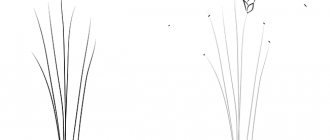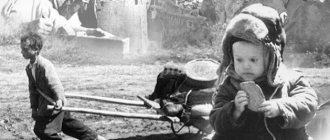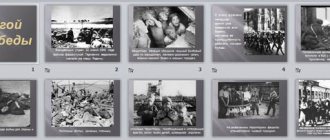Bread of War
At dawn on June 22, 1941, the Great Patriotic War began. For 4 long years until May 9, 1945, our grandfathers and great-grandfathers fought for the liberation of the Motherland from fascism. They did this for the sake of future generations, for our sake. Let us forever preserve the memory of this just war.
1. On the first day of the war they were 17-20 years old. Of every 100 children of this age who went to the front, 97 did not return. 97 out of 100! Here it is, war! 2. War means 1,725 destroyed and burned cities and towns, over 70 thousand villages in our country. War means 32 thousand blown up plants and factories, 65 thousand kilometers of railway tracks.
5. War... The war began on the border of our country and the Brest Fortress took the first blow. From Brest to Moscow - 1000 km, from Moscow to Berlin - 1600 km. Total: 2600 km - this is if you count in a straight line.
6. It seems a little, right? By plane it takes about 4 hours, but by dash and on your belly - 4 years - 1418 days.
7. People died, did not spare their lives, went to their death to drive the Nazis out of our land. 28 Panfilovites, the soldiers were named so in honor of the commander. They did not allow any of the 50-odd enemy tanks to reach Moscow. “Russia is great, but there is nowhere to retreat. Moscow is behind us." While defending the capital, almost all the soldiers died, but they knocked out 50 fascist tanks.
8. Belarusian village Khatyn. It was like this: on March 22, 1943, the small village of Khatyn was surrounded by the Germans. Soldiers broke into peasant huts and threw people out into the street. Residents were herded into a barn. It became more and more crowded inside. Mothers tried to calm their children, but they themselves could not hold back their tears. There were many large families in Khatyn. For example, the Baranovskys have 9 children. The Novitskys have 7. And 19-year-old Vera Yaskevich rocked her seven-week-old son in her arms. They pushed the old men into the barn with rifle butts. The punishers, as the Germans were called, lined the barn with straw, doused it with gasoline and set it on fire. They were burned alive. Many tried to escape from the fire. In vain! The SS men calmly, without fail, shot them with machine guns. For 149 residents of Khatyn, this day was the last. 75 children were martyred. This is war.
4. War is 20 hours at the machine a day. This is a crop grown on soil salty from sweat. These are bloody calluses on the palms of girls and boys just like you.
The Leningrad sky is in smoke,
But worse than mortal wounds
Heavy bread, blockade bread
One hundred twenty-five grams.
Siege bread with a tear in half.
Whoever ate it does not forget about it.
3. War is 900 days and nights of besieged Leningrad. This is 125 grams of bread per day. These are tons of bombs and shells falling on civilians. Galina Pavlovna Vishnevskaya, an opera singer, remembers (Excerpt from the book “Galina”).
“The blockade began... Only a few months had passed since the beginning of the war, and the city was already starving. Fewer and fewer products began to be issued on ration cards. On November 20, 1941, the bread ration reached 125 grams for dependents and 250 grams for workers. Cereals were given out 300 g, oils - 100 g per month. Then the time came when they no longer gave out anything except bread. And these 125 g, on which life depended, were not bread, but a sticky black mess made from flour waste, wet and melting in the hands. Everyone stretched their piece as far as they could...
The Road of Life is the only military-strategic transport route that passed through Lake Ladoga and connected from September 1941 to March 1943. Leningrad and the country besieged by Nazi troops. It was so difficult for people to live in Leningrad.
In our area, people also lived very hard during the war. We worked a lot making shells for the front.
And they also ate very little. Because everything went to the front.
Vinokurov E.M.
Military bread I remember bread. It was black and sticky - The rye flour was rather coarsely ground. But faces blossomed from smiles, When the loaf was placed on the table. Military bread. It was good for Lenten cabbage soup, crumbled, it was not bad with kvass. It stuck in my teeth and stuck to my gums. We separated it with our tongue. It was sour, because it had bran, I can’t guarantee that it was without quinoa. And yet, with greedy lips, I picked up crumbs from the palm of my hand after eating. I always watched with keen interest and with a sinking heart the formidable, cold-blooded bread-cutter. He was cutting bread! He shared black bread! I admired him, direct and honest. He cut roughly, simply, without fancy, with a burnt crust, like charcoal, getting dirty - almost to the elbows. His canvas shirt was wet. He was very enthusiastic about work. He cut bread without knowing fatigue, without wiping his face with his sleeve!
Bread cards were introduced in July 1941. To save money, they began to produce mainly bread from rye flour.
Military bread recipes
- One-tenth of the war bread consisted of potatoes and bran (Bran, a by-product of flour milling. It consists of grain shells and the remains of unsorted flour. Depending on the type of processed grain, there are: wheat, rye, barley, rice. Bran, a by-product of flour milling. Consists of grain shells and residues of unsorted flour. Depending on the type of grain being processed, O. are: wheat, rye, barley, rice. Bran, a by-product of flour milling. Consists of grain shells and residues of unsorted flour. Depending on the type of grain being processed, O. are : wheat, rye, barley, rice, a by-product of flour milling. Consists of grain shells and the remains of unsorted flour. Depending on the type of processed grain, there are: wheat, rye, barley, rice, buckwheat).
Blockade bread: 10–12% is rye wallpaper flour (the coarsest grind of flour), the rest is cake (what remains from the plant after squeezing juice or oil out of it. For example: Sunflower oil is obtained from the seeds, and the cake is given to livestock. ), meal (crushed seeds), flour scraps from equipment and floors, bagging, food pulp, pine needles.
- sugar beet pressing – 40%, bran – 30%, sawdust – 20%, cellulose flour from leaves or straw – 10%.
Beets, potatoes and potato peelings, quinoa.
A standard loaf consisted of 63% rye flour, 4% flaxseed meal, 8% oatmeal, 4% soy flour, and 12% malt flour. The rest consisted of even more minor impurities.
They added chaff, bran, dried and ground straw and hay (or hay dust), tree bark, and stems of young linden trees. In those days, bread was baked without salt - there was none.
Our grandmothers ate this bread. Let's listen to the girls' messages taken from our big project "Echoes of War"
Bread is an ambassador of peace and friendship between peoples. Life changes, but bread-father, bread-breadwinner remains the greatest value.
They escorted us to the front with bread. Those returning from the war were greeted with bread. Bread was used to remember those who would never return. Everyone has their own bread. Everyone remembers, perceives and appreciates it in their own way. But there is one thing in common for everyone without exception: bread is life.
I was not a participant in the war, But according to the stories of my grandparents, Wanting only peace, bread, silence, Fighting, our people forged Victory. I was not a participant in the war. Fortunately, I was born half a century later, but the pain of those years, adding gray hair to my hair, touched every loved one. ...And there will be a long echo of that war.
Salnikova Katya. 10 years.
What conclusion can be drawn from the class material you heard? At the end of the lesson, the video film “Memory”
Bread of war. What was he like?
Instagram YouTube Facebook VKontakte Odnoklassniki Twitter
8
8
- home
- Articles
- Bread of war. What was he like?
May 25, 2016
A brief summary of the article “Bread of War. What was he like?"
The author of the article, Maxim Yurievich Edlin, is a practicing baker-technologist and host of master classes on making artisan bread, a specialist at the Research and Production Moscow State University of Technology named after. K.G. Razumovsky.
According to the author, this article will be of interest to people who are interested in our history and who are not indifferent to the feat of the Soviet people during the Great Patriotic War. This article touches on the topic of the basic diet during the Great Patriotic War. The characteristic features of bread preparation during the fighting of the Soviet army, as well as in the harsh occupation conditions of the besieged Leningrad at that time, are highlighted and described. A comparison is given of the composition of front-line bread in different years of the Great Patriotic War. A description is given of one of the methods of preparing front-line bread, sandwiches based on it and carrot tea, which was very popular among soldiers.
According to the author, this article clearly reflects the enormous importance of bread - the measure of life as a staple food during the war.
Key words: war bread, front-line bread, carrot tea, composition of front-line bread, workers' bread.
You can ORDER FRONT BREAD >>> here.
At almost all of my master classes I talk about the bread traditions of Ancient Rus' and only briefly touch on the topic of the Great Patriotic War. This time I decided to correct this mistake, and decided to write about Bread during the war, when our great-grandfathers and grandfathers defended the Motherland from fascist invaders. What was he like, this bread of war? This is what my new article is about.
This front-line Bread was bitter, literally and figuratively. Its composition often included components that in ordinary life no one would even think of adding to bread. So what was the main food product made of during this difficult war time? And what was it made of...
In the active army, according to the standards established by the government in September 1941, the diet of an ordinary soldier consisted of 80% bread, 800 grams of it. In the photo below is a card for bread in Saratov, dated April 1942. After this time the situation only worsened.
The bread that was brought to the front from the rear consisted of 40 percent rye flour (that is, milled from whole grains without waste), soy flour, seed meal (makukha), and beet cake. This is of course in a good situation. In the last years of the war, flour in such bread was only 10% or even less than 5%.
Front-line bakers baked bread right on the battlefields - in earthen ovens built right in the trenches. And we had to do this even sometimes under fire. In addition to rye flour, beet cake, malt, and bran, the composition of front-line bread sometimes also included sawdust.
Those who remained in the rear did not eat any better. It was more difficult for them, since the main supply of grain went to the front, they had to make bread from what they had. According to a recipe developed by the Moscow Technological Institute of the Food Industry, potatoes, bran, the same cake, macadamia, as well as nettle, quinoa and other more or less edible herbs were added to the “working bread”.
For example, wartime bread could consist of oats and barley husks (about 4 tablespoons of oats, 2 tablespoons of barley husks per 100 g of water) or Quinoa and bran bread (quinoa 150 g, bran 150 g and water 100 g). This takes into account the fact that people worked a lot physically and it took a lot of strength to provide the front with everything necessary.
During the war, bread was considered the measure of life. Many people know that in besieged Leningrad there was an equal sign between bread and life. And this was indeed the case. During the 900 days of the blockade, the bread quota for city residents was reduced five times. Leningraders received the most minimal food ration from November 20 to December 24, 1941: workers - 250 g of bread, everyone else - 125 g. This is the piece that helped the residents of Leningrad survive.
It’s scary to think, but even such bread, half consisting of practically inedible impurities - wallpaper dust, bran, cellulose, sawdust, cake, etc., was sorely lacking.
Here is one way to prepare such bread:
To begin with, potatoes must be boiled in their skins, then peeled and passed through a meat grinder to obtain the so-called dry mashed potatoes. Then the resulting mass was placed on a baking sheet, previously sprinkled with a small amount of bran. The potatoes cooled for several minutes, after which the remaining bran was added, salted and the dough was quickly kneaded. Then the baking dish was greased with vegetable oil, the mixture was placed in it and baked in the oven until done for an hour at a not very high temperature.
Such a simple pleasure as camp cooking did not always accompany the soldiers of the Red Army: in some campaigns they had to make do on their own. And then the soldiers prepared themselves front-line sandwiches: not only healthy and nutritious, but also to prevent colds.
Cooking method:
This sandwich was prepared extremely simply: onions, garlic and lard, cut into small cubes, are placed in a pot and mixed with a spoon until smooth, which is then spread on black bread. The indicated proportions were enough for three or even four fighters to have a hearty breakfast, and at the same time replenish their daily supply of vitamins.
And finally, I’ll say a few words about front-line drinks. Carrot tea was very popular among soldiers. To prepare it, dried carrots were used, prepared using the following technology: the vegetable was peeled, grated, dried in the oven, after which the dried carrots could be used as tea leaves, pouring boiling water over it and infusing for 5-10 minutes. Carrots gave the tea a sweetish taste, and gave the soldiers an additional boost of energy and benefit to the immune system.
I thank my Grandfather Victor and Great-grandfather Yakov for surviving these difficult years together with the ancestors of my friends and acquaintances, not disgracing the Russian Land and saving our Fatherland! Low bow to them!
In memory of these difficult years, I reconstructed the recipe for such bread. Who wants to try what happened?
you can order here.
With love and warmth, Maxim Yedlin.
Phil, August 05, 2019
Glory to our grandfathers and grandmothers!!! Glory to our heroes who won our right to life!!!



